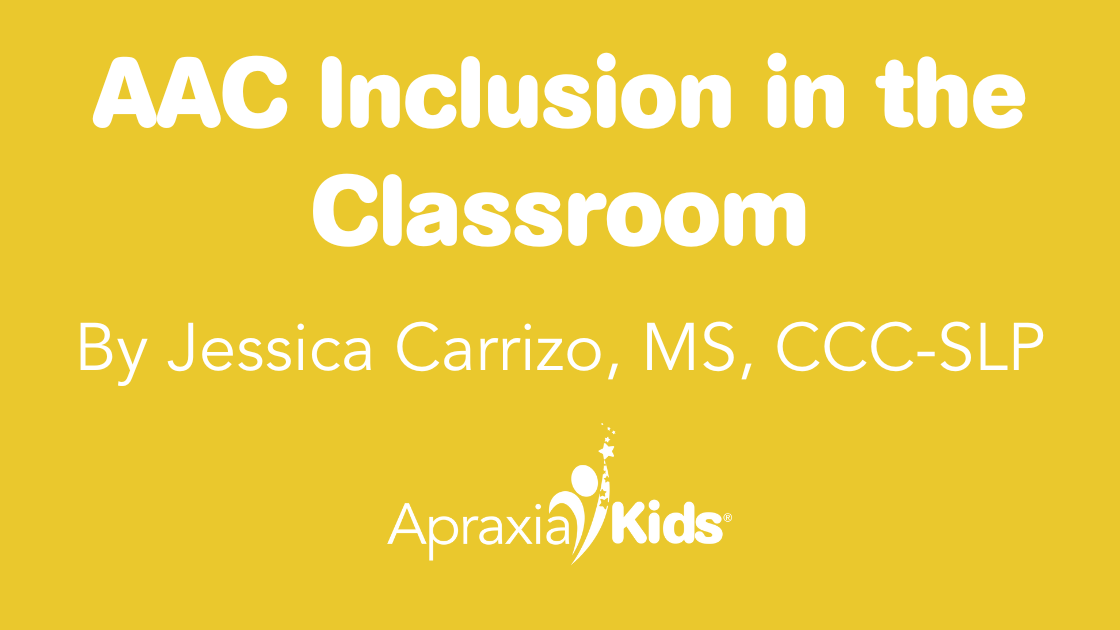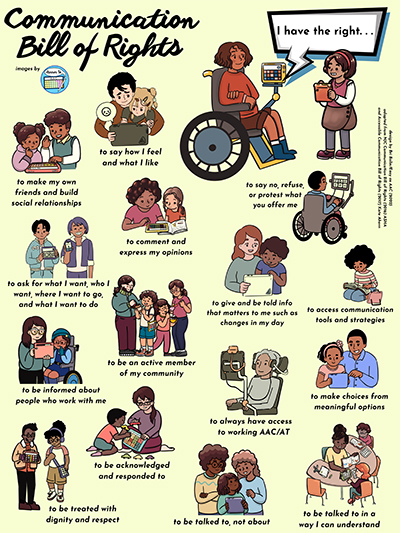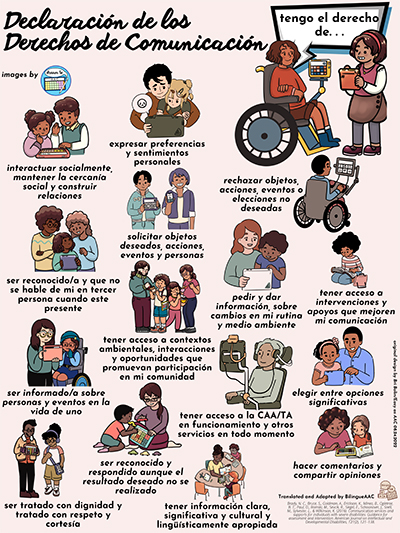
02 Oct AAC Inclusion in the Classroom
By Jessica Carrizo, MS, CCC-SLP
Member of the Diversity & Inclusion Task Force for Apraxia Kids
Imagine walking into a Spanish/English dual immersion classroom…
First you will notice the classroom decor will include the Spanish language and latino/x culture. The teacher will most likely greet students in Spanish, English, or both. It is evident by the environment and attitudes that one language is not more valued than the other. Storybooks and lessons are selected to ensure students’ culture and languages are represented. “Code switching” (alternating between languages) is a common practice among students and adults in the classroom. Instead of isolating Spanish and English, the teacher guides students to utilize all of their linguistic abilities and make connections across both languages. School staff outside of the classroom often speak Spanish to students in the office, playground, and hallways.
Augmentative Alternative Communication (AAC) is a language. Children with Childhood Apraxia of Speech (CAS) often use and benefit from AAC while working towards improving their ability to communicate verbally. When a student is using an AAC system in a general education classroom, their language needs to be represented and valued. The teacher and classmates need access to additional systems/devices in order to use AAC. The classroom environment should have AAC symbols throughout to represent all languages of the classroom. The teacher and classmates need to receive ongoing training for modeling and use of the AAC system. Each lesson should incorporate AAC with opportunities to respond and participate using AAC. Both the AAC user and peers should be encouraged to mix AAC and verbal communication to more easily communicate their message. Campus staff should be familiar with AAC and facilitate opportunities for inclusion.
Wait, all of this for one student? Is it too much? No, it is the minimum.
I have had the privilege of supporting bilingual AAC users with CAS in dual immersion classrooms in the United States. Dual immersion refers to any program that provides literacy and content instruction to all students through two languages and that promotes bilingualism and biliteracy, grade-level academic achievement, and multicultural competence for all students (Howard, 2007). Dual immersion teachers get it! Why would we limit a student’s potential to one language when their linguistic abilities are spread across both? AAC is a language, a minority language, and this year our class is trilingual. It sounds simple but an incredible amount of effort, collaboration, and dedication is required from all team members to effectively include AAC in the general education classroom. The speech-language pathologist can guide the team by creating a Communication Participation Plan where materials, accommodations, and responsibilities of team members are clearly laid out across all parts of the school day. This can help the team plan ahead for not only anticipating the need for alternative response methods when verbal communication is difficult, but also customization of the AAC system to better access academic content. Providing direct training to teachers and peers on AAC is essential to establishing AAC as one of the classroom languages. We cannot place a child in a general education classroom with an AAC system without carefully planning for their academic and social success.
Howard, E. R., Sugarman, J., Christian, D., Lindholm-Leary, K. J., & Rogers, D. (2007). Guiding principles for dual language education (2nd ed.). Washington, DC: Center for Applied Linguistics.
Sample Participation Plan Worksheet (Fonner, 2008 adapted from Beukelman & Mirenda, 2005)
https://techknowledgy.ttaconline.org/TechKnowledgy2014/Document/5JRqwgM2VS0
Download and Share this “Communication Bill of Rights”
Communication is a basic right, regardless of what that communication looks like! This Communication Bill of Rights is a great way to remind others that everyone deserves a voice. Share with your community to make communication and AAC inclusive for all!
Design by Bri Bolin/Easy as AAC (2022). Adapted from NJC Communication Bill of Rights (2016) ASHA and Accessible Communication Bill of Rights (2017) Kate Ahern. Images by Drawn to AAC. Translated and Adapted by BilingueAAC.
English – Communication Bill of Rights
By Jessica Carrizo, MS, CCC-SLP
Member of the Diversity & Inclusion Task Force for Apraxia Kids
Imagine walking into a Spanish/English dual immersion classroom…
First you will notice the classroom decor will include the Spanish language and latino/x culture. The teacher will most likely greet students in Spanish, English, or both. It is evident by the environment and attitudes that one language is not more valued than the other. Storybooks and lessons are selected to ensure students’ culture and languages are represented. “Code switching” (alternating between languages) is a common practice among students and adults in the classroom. Instead of isolating Spanish and English, the teacher guides students to utilize all of their linguistic abilities and make connections across both languages. School staff outside of the classroom often speak Spanish to students in the office, playground, and hallways.
Augmentative Alternative Communication (AAC) is a language. Children with Childhood Apraxia of Speech (CAS) often use and benefit from AAC while working towards improving their ability to communicate verbally. When a student is using an AAC system in a general education classroom, their language needs to be represented and valued. The teacher and classmates need access to additional systems/devices in order to use AAC. The classroom environment should have AAC symbols throughout to represent all languages of the classroom. The teacher and classmates need to receive ongoing training for modeling and use of the AAC system. Each lesson should incorporate AAC with opportunities to respond and participate using AAC. Both the AAC user and peers should be encouraged to mix AAC and verbal communication to more easily communicate their message. Campus staff should be familiar with AAC and facilitate opportunities for inclusion.
Wait, all of this for one student? Is it too much? No, it is the minimum.
I have had the privilege of supporting bilingual AAC users with CAS in dual immersion classrooms in the United States. Dual immersion refers to any program that provides literacy and content instruction to all students through two languages and that promotes bilingualism and biliteracy, grade-level academic achievement, and multicultural competence for all students (Howard, 2007). Dual immersion teachers get it! Why would we limit a student’s potential to one language when their linguistic abilities are spread across both? AAC is a language, a minority language, and this year our class is trilingual. It sounds simple but an incredible amount of effort, collaboration, and dedication is required from all team members to effectively include AAC in the general education classroom. The speech-language pathologist can guide the team by creating a Communication Participation Plan where materials, accommodations, and responsibilities of team members are clearly laid out across all parts of the school day. This can help the team plan ahead for not only anticipating the need for alternative response methods when verbal communication is difficult, but also customization of the AAC system to better access academic content. Providing direct training to teachers and peers on AAC is essential to establishing AAC as one of the classroom languages. We cannot place a child in a general education classroom with an AAC system without carefully planning for their academic and social success.
Howard, E. R., Sugarman, J., Christian, D., Lindholm-Leary, K. J., & Rogers, D. (2007). Guiding principles for dual language education (2nd ed.). Washington, DC: Center for Applied Linguistics.
Sample Participation Plan Worksheet (Fonner, 2008 adapted from Beukelman & Mirenda, 2005)
https://techknowledgy.ttaconline.org/TechKnowledgy2014/Document/5JRqwgM2VS0
Download and Share this “Communication Bill of Rights”
Communication is a basic right, regardless of what that communication looks like! This Communication Bill of Rights is a great way to remind others that everyone deserves a voice. Share with your community to make communication and AAC inclusive for all!
Design by Bri Bolin/Easy as AAC (2022). Adapted from NJC Communication Bill of Rights (2016) ASHA and Accessible Communication Bill of Rights (2017) Kate Ahern. Images by Drawn to AAC. Translated and Adapted by BilingueAAC.
English – Communication Bill of Rights
Credentials:
Hours of Operation:
Treatment locations:
Address:
,
Phone:
Email:
Overall Treatment Approach:
Percent of CAS cases:
Parent Involvement:
Community Involvement:
Professional consultation/collaboration:
Min Age Treated:
Max Age Treated:
Insurance Accepted:






